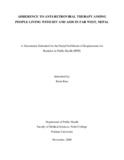Please use this identifier to cite or link to this item:
https://hdl.handle.net/20.500.14356/784| Title: | Adherence To Anti-Retroviral Therapy Among People Living With HIV And AIDS In Far West, Nepal |
| Authors: | Bam, Kiran |
| Issue Date: | 2009 |
| Abstract: | Adherence is a term used to describe the act of following a course of medication in exactly the manner it is prescribed. Adherence is sometimes also called compliance. Adherence to ART is second largest predictor of progression to AIDS and death after CD4 count/reduced HIV RNA replication. In ART, adherence is essential for successful treatment and sustained viral control. To achieve treatment success requires near‐perfect adherence to combination ARV regimens. Very little is known about the adherence to ART in Nepal despite the initiation of the program more than half a decade ago. The general objective of the study is to determine the Adherence ART among People Living with HIV and AIDS in Far West, Nepal. The specific objectives are to determine the adherence rate to ART; to asses factors associated with adherence to ART; and to generate recommendations in the development of adherence optimizing interventions. This is a cross sectional study which employed both quantitative and qualitative methods to identify magnitude of adherence and to identify protective and risk factors to adherence to ART among HIV infected persons. The semi structured questionnaire schedule was adapted from The Challenges to ART, study conducted in Botswana, Tanzania and Uganda to understand access to adherence. The questionnaire was pre tested and modified to cultural context then translated in Nepali. Study was conducted in Far West of Nepal from May 2009 to September 2009 in all four ART sites. Clients of age 15 years above and taking ARVs for at least 3 months were enrolled in the study. A total of 176 samples allowed with 95% CI and 5% error proportionately ART sites were drawn. Random sampling technique was employed among the client visiting the ART centre. Data management and analysis was done in datasheet created in Statistical Package for Social Sciences (SPSS). Mean and standard deviation were calculated for the adherence rate. Bivariate analysis of variables was carried out to determine the factors for adherence. Verbal informed consent was taken from each research participants before data collection following the ethical norms and values as stated in the National Ethical Guidelines for Health Research in Nepal, 2001. The overall adherence for one month was 84 percent. The major reason for missing the drugs was identified as being too busy and forgetting which are closely interrelated. Similarly, travel distance and travel cost was also identified as cause for discontinuation of the treatment. Those who were more than 95 percent adherent responded that use of watch, electronic devices such as mobiles and mass-media facilitated them to take the drugs regularly. The study showed a significant association between the adherence and the area of residence, prior alcohol and smoking habit, disclosure of the HIV status. Other factors that were found to be significantly affecting the adherence are the perceived benefit of the ART and Patient satisfaction with the provider. Travel Cost was identified as one of the significant barrier to adherence. There was no significant association of adherence with age, sex, religion, and education al and employment status. The finding that age, sex, marital status, education level and employment status did not significantly affect adherence was similar to other studies elsewhere. The results established that being away from home contributed to poor timing of taking drugs among the patients. The adherence rate found in this study seems to be encouraging. The findings emphasized the importance of multiple periodic assessments of adherence errors. Timely detection of non-adherence behaviors and appropriate monitoring of patients' difficulties with ART could potentially help patients to maintain adherence and therefore improve the treatment outcome. Future research should investigate the cause of disparity in adherence between refills and time of taking ARV drugs, utilization of multiple measures of adherence to be incorporated in the care plans and multiple-target interventions focused to resolve the barriers to adherence should be implemented based on barriers defined to be potentially or actually present. |
| URI: | http://103.69.126.140:8080/handle/20.500.14356/784 |
| Appears in Collections: | Post Graduate Grant (PG) Reports |
Items in DSpace are protected by copyright, with all rights reserved, unless otherwise indicated.

